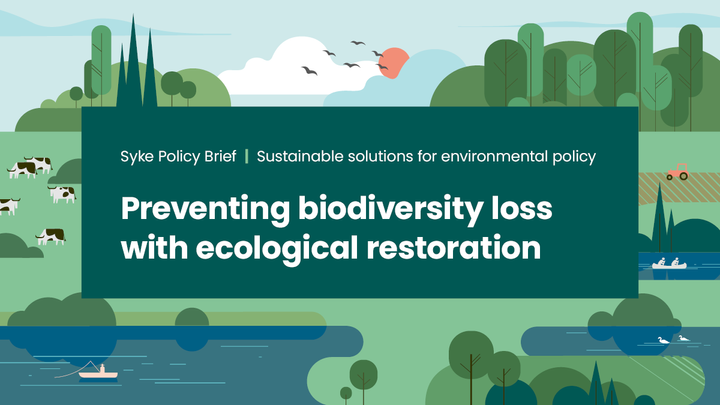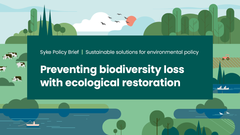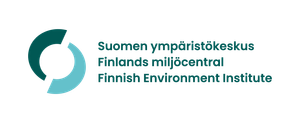Syke Policy Brief: Preventing biodiversity loss with ecological restoration

The aim of restoration is to bring a degraded or damaged natural habitat back to a good ecological state. Habitat restoration recovers ecosystem functions, which are a prerequisite for the sustainability of our society. Restoration also advances the resilience of ecosystems, improving their ability to recover from, for example floods, drought, or insect damage.
“Restoration is most effective when measurable national goals are set for it, and when all sectors in society commit to these goals. Getting landowners, entrepreneurs, citizens, and authorities to join the effort is crucial for the success of restoration. Also sectors responsible for the damage need to be engaged”, Syke’s Director General Leif Schulman emphasises.
“Restoration means reversing human-caused damage on nature, but it does not justify continuing degrading activities elsewhere. Also, protection and maintaining a good state of nature is always more cost-effective than fixing damage afterwards”, underlines Syke’s Research Director Eeva Primmer.
Finland needs comprehensive and systemic restoration planning
“With 76 percent of Finland's forest biotopes threatened, it is understandable that the need for protection is great despite the considerable forest cover”, says Aija Kukkala, Senior Coordinator from Syke. Wetlands have suffered much from drainage and land conversion. Currently, 60 % of our original wetland area is no longer in a natural state. Flowing waters and springs are the most threatened inland waterway biotopes. Up to 20 % of biotope types in inland waters are threatened.
“The key to successful restoration is to target the measures at sufficiently large units.
For example, planning on a catchment area level can ensure that forest drainage in the upstream parts of a river basin does not harm water quality downstream”, Kukkala adds.
In southern parts of Finland, the need for restoration is great because most of the natural areas are under great pressure. For example, in Southern Finland, only one percent of all streams are in a natural state. Land use in the catchment area is the main reason for the poor condition of streams. Forest clear cuts and drainage have greatly altered the natural state of brooks.
Changes in the environmental governance are needed to restore and halt further deterioration of streams. Regulation of drainage in the Water Act should be developed in a more environmentally friendly direction, and the Forest Act should be amended to require an adequate protective zone around all brooks, streams, and springs to secure the nature values of streams and riparian forests. Legislation should require landowners to add structural features, such as retention trees and decaying wood, to enhance the biodiversity of their forests. Forest owners are generally willing to protect small waterbodies in their own forests.
Systematic monitoring is needed
“It is not enough to simply carry out restoration measures. It is also important to monitor restored areas over a long period, because the effects and benefits of restoration emerge with a delay” emphasises Senior Research Scientist Saija Koljonen from Syke.
“In addition, information on restored areas and restoration methods is currently dispersed. Restoration measures, monitoring results, and impact assessments on nature should be compiled to enable regional targeting”, Koljonen adds.
Methods are needed to evaluate the monetary benefits of restoration. “It is worthwhile to compare the benefits with the costs imposed by deterioration of the living environment. When evaluating the benefits and costs it is also important to recognise the beneficiaries and the payers. Although it is difficult to evaluate the monetary benefits of restoration, developing suitable methods is worth the effort”, Eeva Primmer says. Restoration increases restoration increases the quantitative and qualitative benefits that humans derive from nature.
The funding of restoration should be based on nature values
Restoration measures and targeting them effectively can be governed through both legislation and incentives. “Subsidies should be based on the biodiversity value of the area, taking the bounds of EU subsidies regulation into account. Also, the level of subsidies should depend on the benefits to be gained from restoration”, says Minna Pappila, Senior Research Scientist from Syke. She adds:
“The introduction of the polluter pays principle for projects that degrade nature would be an incentive to reduce harm; with the offsetting obligation linked to it, restoration could be targeted to places where it is most cost-effective.”
In the future, biodiversity offsetting market could generate private sector funding for restoration work and further help biodiversity conservation. New restoration practices and innovations generate jobs, and broader implementation of environmental responsibility can improve the competitiveness the companies involved.
Syke Policy Brief: Tackling biodiversity loss through ecological restoration (helda.helsinki.fi)
This policy brief has also been published in Finnish and Swedish.
Syke Policy Brief: Luontokatoa voidaan torjua ennallistamalla (helda.helsinki.fi)
Syke Policy Brief: Biodiversitetsförlusten kan bekämpas med restaurering (helda.helsinki.fi)
Further information:
Senior Research Scientist Saija Koljonen (restoration, freshwaters), Syke
firstname.lastname@syke.fi tel. +358 295 251 791
Senior Coordinator Aija Kukkala (restoration, protected areas), Syke
firstname.lastname@syke.fi tel. +358 295 251 244
Senior Research Scientist Minna Pappila (legislation, biodiversity), Syke
firstname.lastname@syke.fi tel. +358 295 252 233
All Syke Policy Briefs (Issuu.com)
SYKE Policy Briefs are concise summaries of a particular issue, the policy options to deal with it, and some recommendations on the best option. It is aimed at government policymakers and others who are interested in formulating or influencing policy.
Keywords
Contacts
Media service at Finnish Environment Institute
The Finnish Environment Institute's Media Service provides information on our research, helps journalists find experts for interviews and provides photos for media use.
Our Communication experts will answer your inquiries on weekdays from 9 am to 4 pm.
Images
Links
About Suomen ympäristökeskus
It is time to move beyond solving environmental problems one by one, to systemic sustainability transformations. The Finnish Environment Institute (Syke) contributes to building a sustainable society through research, information and services. The Finnish Environment Institute is a research institute with 700 experts and researchers located in Helsinki, Oulu, Jyväskylä and Joensuu.
Subscribe to releases from Suomen ympäristökeskus
Subscribe to all the latest releases from Suomen ympäristökeskus by registering your e-mail address below. You can unsubscribe at any time.
Latest releases from Suomen ympäristökeskus
Viikkokatsaus 8.–12.12.20254.12.2025 12:30:18 EET | Tiedote
Hei! Tässä tiedoksesi meillä Suomen ympäristökeskuksessa ensi viikolla ilmestyviä tiedotteita, uutisia, kampanjoita, blogeja ja uutiskirjeitä. Mukana myös tulevia tapahtumia ja webinaareja. Jakelemme viikkokatsauksen torstaisin STT:n kautta. Koosteet löytyvät myös STT-uutishuoneesta, josta voit tilata kaikki Suomen ympäristökeskuksen tiedotteet.
Fisk och kilowattimmar kan förenas i Kymmene älv3.12.2025 08:53:17 EET | Pressmeddelande
Vandringsfiskens livsmiljöer kan förbättras genom smarta flödesläsningar utan betydande förluster för energiproduktionen.
Kymijoella mahdollista yhdistää kalat ja kilowattitunnit3.12.2025 08:51:25 EET | Tiedote
Vaelluskalojen lisääntymismahdollisuuksia voidaan parantaa virtaamajärjestelyillä ilman merkittäviä menetyksiä energiantuotannolle.
Viikkokatsaus 1.–5.12.202527.11.2025 12:04:01 EET | Tiedote
Hei! Tässä tiedoksesi meillä Suomen ympäristökeskuksessa ensi viikolla ilmestyviä tiedotteita, uutisia, kampanjoita, blogeja ja uutiskirjeitä. Mukana myös tulevia tapahtumia ja webinaareja. Jakelemme viikkokatsauksen torstaisin STT:n kautta. Koosteet löytyvät myös STT-uutishuoneesta, josta voit tilata kaikki Suomen ympäristökeskuksen tiedotteet.
Finland must accelerate efforts towards a circular economy of plastics27.11.2025 07:02:00 EET | Press release
Progress has been made in advancing the circular economy for plastics, but Finland remains far from its targets and significant additional measures are needed. A new report from the PlastLIFE project, published by the Finnish Environment Institute, highlights how reducing unnecessary plastic consumption, preventing littering, and improving recycling efficiency are key to achieving a circular economy. The issue is pressing, as plastics continue to have considerable climate and environmental impacts. Finland’s goal is to establish a sustainable circular economy for plastics by 2030.
In our pressroom you can read all our latest releases, find our press contacts, images, documents and other relevant information about us.
Visit our pressroom

